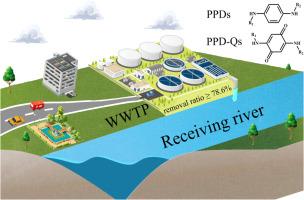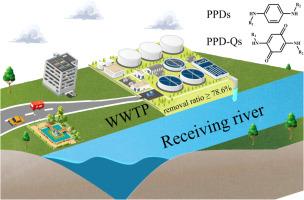对苯二胺及其醌类化合物在污水处理厂中的存在、命运和手性特征
IF 12.4
1区 环境科学与生态学
Q1 ENGINEERING, ENVIRONMENTAL
引用次数: 0
摘要
对苯二胺(PPDs)及其衍生物醌(PPD-Qs)是新兴的污染物。关于它们在污水处理厂及其接收水中的发生、命运和手性特征的信息很少。本研究探讨了广州两个污水处理厂中这些污染物的分布、去除效率、质量平衡、环境排放和对映体组分。它还审查了污水处理厂废水对这些污染物在接收河流中的分布的影响。进水中Σ(PPDs+PPD-Qs)浓度为3.95 ~ 20.4 ng/L,出水中为0.69 ~ 3.94 ng/L,污泥中为2.14 ~ 19.8 ng/g干重。污水处理厂中PPDs(81.6%)和PPD-Qs(78.6%)主要通过生物转化得到有效去除,但污泥吸附和分离也有助于去除。其中一个污水处理厂可能会增加接收河流下游这些污染物的水平,表明污水处理厂出水是水生环境ppd和PPD-Qs的重要载体。研究结果还表明,6PPD和6PPD- q的非外消旋手性特征在两种污水处理剂和接收水之间存在差异,值得进一步研究其机制。未来的研究应阐明ppd和ppd - q可能对接收河流造成的环境风险,并在对映体水平上准确评估这种影响。本文章由计算机程序翻译,如有差异,请以英文原文为准。


Occurrence, fate and chiral signatures of p-phenylenediamines and their quinones in wastewater treatment plants, China
p-Phenylenediamines (PPDs) and their derived quinones (PPD-Qs) are emerging pollutants. Information on their occurrence, fate and chiral signatures in the wastewater treatment plant (WWTP) and its receiving waters is scarce. This study explored the distribution, removal efficiency, mass balance, environmental emission and enantiomeric fractions of these pollutants in two WWTPs in Guangzhou, China. It also examined the impacts of WWTP effluents on the distribution of these contaminants in the receiving rivers. The concentrations of Σ(PPDs+PPD-Qs) ranged from 3.95 to 20.4 ng/L in influent, 0.69–3.94 ng/L in effluent, and 2.14–19.8 ng/g dry weight in sludge, respectively. PPDs (81.6 %) and PPD-Qs (78.6 %) were effectively removed in the WWTPs primarily through biotransformation, but sludge adsorption and separation also contributed to the removal. One of the WWTPs could increase the levels of these pollutants in the downstream of receiving river, suggesting that WWTP effluents are significant vectors of PPDs and PPD-Qs to the aquatic environment. The results also highlight different nonracemic chiral signatures of 6PPD and 6PPD-Q between the two WWTPs and the receiving waters, which merit further investigation for mechanism. Future studies should elucidate the environmental risks that PPDs and PPD-Qs may pose to receiving rivers and accurately assess such effects at the enantiomeric level.
求助全文
通过发布文献求助,成功后即可免费获取论文全文。
去求助
来源期刊

Water Research
环境科学-工程:环境
CiteScore
20.80
自引率
9.40%
发文量
1307
审稿时长
38 days
期刊介绍:
Water Research, along with its open access companion journal Water Research X, serves as a platform for publishing original research papers covering various aspects of the science and technology related to the anthropogenic water cycle, water quality, and its management worldwide. The audience targeted by the journal comprises biologists, chemical engineers, chemists, civil engineers, environmental engineers, limnologists, and microbiologists. The scope of the journal include:
•Treatment processes for water and wastewaters (municipal, agricultural, industrial, and on-site treatment), including resource recovery and residuals management;
•Urban hydrology including sewer systems, stormwater management, and green infrastructure;
•Drinking water treatment and distribution;
•Potable and non-potable water reuse;
•Sanitation, public health, and risk assessment;
•Anaerobic digestion, solid and hazardous waste management, including source characterization and the effects and control of leachates and gaseous emissions;
•Contaminants (chemical, microbial, anthropogenic particles such as nanoparticles or microplastics) and related water quality sensing, monitoring, fate, and assessment;
•Anthropogenic impacts on inland, tidal, coastal and urban waters, focusing on surface and ground waters, and point and non-point sources of pollution;
•Environmental restoration, linked to surface water, groundwater and groundwater remediation;
•Analysis of the interfaces between sediments and water, and between water and atmosphere, focusing specifically on anthropogenic impacts;
•Mathematical modelling, systems analysis, machine learning, and beneficial use of big data related to the anthropogenic water cycle;
•Socio-economic, policy, and regulations studies.
 求助内容:
求助内容: 应助结果提醒方式:
应助结果提醒方式:


